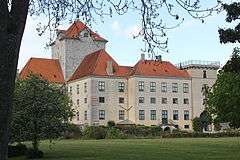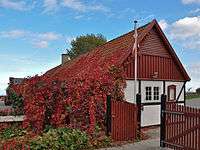Gjorslev
| Gjorslev | |
|---|---|
 Gjorslev | |
| General information | |
| Architectural style | Gothic, Baroque |
| Location | Stevns Municipality |
| Country | Denmark |
| Coordinates | 55°21′16″N 12°22′40″E / 55.3545°N 12.3779°ECoordinates: 55°21′16″N 12°22′40″E / 55.3545°N 12.3779°E |
| Construction started | 1400 |
| Completed | 1588 |
| Client | Peder Jensen Lodehat |
Gjorslev is a cruciform medieval castle located 17 km south-east of Køge, on the island of Zealand, in Denmark. Originally owned by the Bishop of Roskilde, it is considered one of the most well-preserved examples of Gothic secular architecture in Denmark.
History
Gjorslev was built in about 1400 by Peder Jensen Lodehat, Bishop of Roskilde. It remained in the possession of the Roskilde bishops until the Reformation which led to its confiscation in 1637. It was sold in 1540 and was then in the possession of changing owners until 1678 when it came under the Crown once again. It was then owned by the Lindencrone family from 1763 to 1791, from 1793 to 1923 by the Scavenius family, and from 1925 and until the present day it has been in the possession of the Tesdorpf family.[1]
Architecture
Gjorslev is surrounded by moats and built to a cruciform design in the Gothic style. The building materials are a combination of local limestone from the Cliffs of Stevns and large bricks (Danish "monk stones").[2]
The central tower is just under 30 m tall and has seven storeys. The south arm of the cross is slightly longer than the other three. A lower north wing was added in 1638.
Access to the main building was originally through the celler from an entrance below the bishop's chapel which was located on the east side of the southern cross arm. From the vaulted celler below the tower, a flight of stairs led to the domed hall in its ground floor. This arrangement was altered by Ewert Janssen between 1665 and 1676. The chapel was demolished and the entrance moved to the eastern cross arm which was also given a new facade and an internal staircase in the Baroque style.[1]
The design of the roof was adapted in 1748 when the original crow-stepped gable with blank arches were replaced by hipped roofs and a pyramidical roof on the tower.[2] The last time the building was altered was in 1843 when a long south wing was added.[2]
The castle stands at the end of a street known as "Broad Street" which is lined by red timbered farm buildings from 1713.
Estate

Gjorslev Beech Forest (Gjorslev Bøgeskov) belongs to the estate. The forest contains a small lake, Møllesøen ("The Mill Lake"), which was a rich has a rich bird life. An observation tower has been built at the site. The forest also contains 55 burial mounds of which the longest, Fruehøj, is 51 metre long. Access to the forest is from Traktørstedet Gjorslev Bøgeskov, a restaurant.[3]
See also
References
- 1 2 "Gjorslev" (in Danish). Gyldendal. Retrieved 2011-10-20.
- 1 2 3 "Gasværket". astoft.com. Retrieved 2010-01-04.
- ↑ "Ghorslev Bøgeskov" (in Danish). Visit Stevns. Retrieved 2014-07-30.
External links
| Wikimedia Commons has media related to Gjorslev. |
- Official website (in Danish)